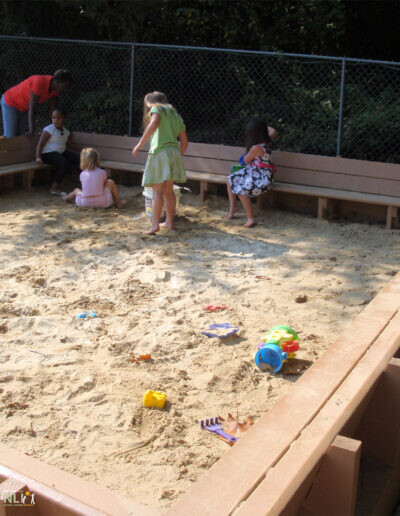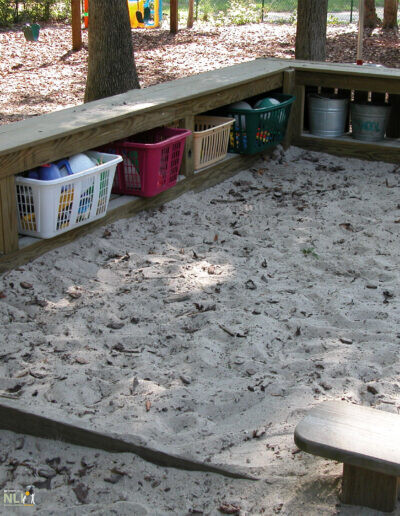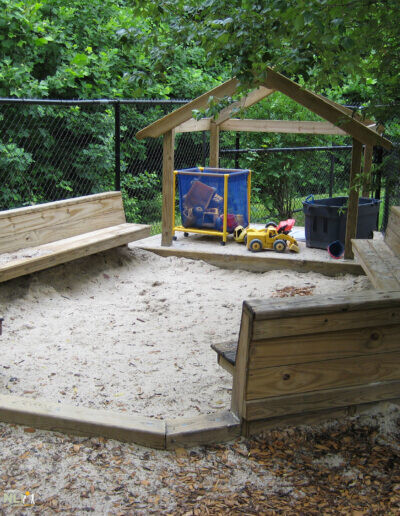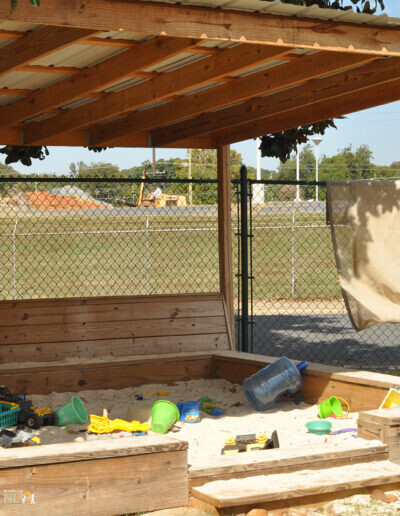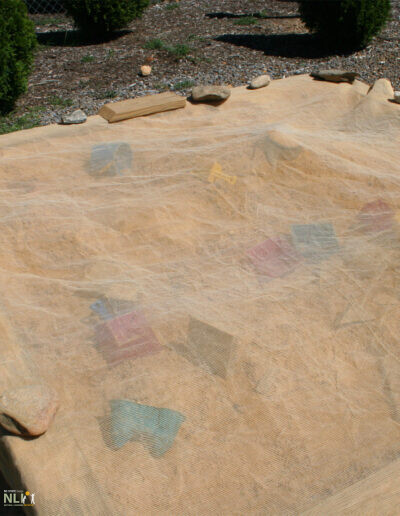15. Sand Play Settings
Sand play is a universal, early childhood activity from toddlerhood through the early school years. The manipulable quality of sand stimulates endless play sequences combining imaginative, social, and constructive play that also support informal STEAM learning. Size and construction methods include custom-designed containers made from dimensioned lumber and sand play bounded by anchored rocks or logs. Easy-to-install “sandbox” kits or ready-made plastic versions are usually too small to meet best practice standards for childcare centers. Good drainage is essential.
Materials
Dimensioned lumber, because of its design flexibility, is the best choice for constructing an enclosed, high quality sand play setting. Use cedar, pressure-treated lumber, or manufactured composite lumber. Consult licensed contractors and/or design professionals for help with construction details before installing.
Logs, partially buried or laid horizontally, can provide an alternative, cost-effective enclosure method, especially if locally available.* Using large stones or smooth rocks is a similarly cost-effective, more permanent method, especially if locally available or “unearthed” on site.
Play sand is recommended as it is graded and washed to remove fine silica dust, which can be harmful to lungs. Play sand is safe for children and can be purchased from local hardware stores.
Manufactured sand play toys such as shovels, buckets, molds, trucks, and figurines can greatly extend play value.
Natural loose parts such as sticks, fallen leaves, pine needles, flower heads and petals, and large seeds such as acorns will enhance sand play and connect children to nature. Point out nearby plants or flowers they can pick to decorate sandcastles and other creations.
Design Considerations
Location. Locate sand play settings against a boundary fence or tucked into a corner away from more active areas. This will reduce “sand migration” (a serious maintenance issue). Do not place immediately next to a concrete pathway where sand can be a slip hazard. Locate away from building entrances to keep sand from tracking indoors. Avoid low spots where drainage may be challenging.
Water adds play value when combined with sand. Include a water source within the setting operated via a spring-loaded button/faucet, with built-in drainage. Alternatively, locate the setting close to a water source and leave children to carry water in pails or recycled containers.
Setting size. A sand play setting can range between 40–300 square feet, depending on available space and age of children served.
Configuration. Design with raised edges and a single entry/exit to keep sand contained. Consider continuous, benched edges and/or a central rock or table to increase play surface area and seating options. Make the space large enough for several groups to play simultaneously.
Depth of sand between 18–24 inches is best practice, allowing kids to really dig without reaching the bottom. Substrate between sand and native soil protects against contamination and weed growth. Best practice is concrete pavers with gaps between for drainage, laid on landscape fabric. Fabric alone will become exposed and torn over time. Ensure excavation accommodates depth of sand and substrate.
Storage cubbies for play props (shovels, trucks, molds and other loose parts) can be located under seating benches or along the sides of the setting, easily accessible to children.
Shade is critical to protect children from harmful sun exposure. Shade can be provided by “shade sails,” suspended over the setting or with vine-covered pergolas constructed from lumber or welded rebar. Shade trees can replace temporary structures once they are mature.
Adjacent planting, including vines on an adjacent fence, flowering plants, and overhanging shade trees, can provide rich, seasonal sources of natural loose parts. A plant buffer also helps to contain “migrating” sand. Large shrubs, grasses, and hardy perennials work well.
Health and Safety
- To deter animals when not in use (a common licensing requirement), cover sand with a light, fine mesh net (not tarp material, which is difficult to manage and causes sand to become rancid). The net covering will prevent contamination by cats and other critters but allow sun, rain, and air to keep the sand fresh. As net is light and does not catch the wind, it can be held down by small weights tied to each corner (small repurposed bottles filled with colored water, large metal nuts, or pipe unions from the local hardware store).
- Maintain boundary fence required height. Typical licensing requirement for boundary fence height is a minimum of 48 inches. A sand play setting built against a boundary fence may reduce the effective height so the height requirement is no longer met. In such a case, extend the fence height behind the setting by adding lattice or similar material. Check local licensing and regulatory policies to ensure that minimum height requirements are met.
- Use “play sand,” as mentioned above.
Resources
*See InfoSheet: Gathering Settings Created with Logs for details on how treat logs for longevity and to ensure that they are child-safe.

